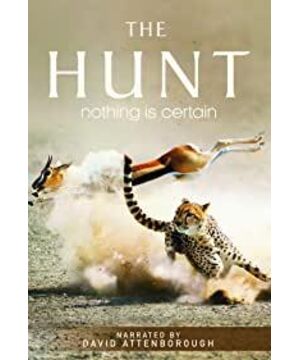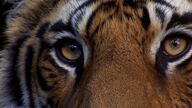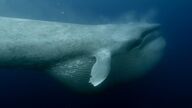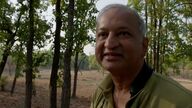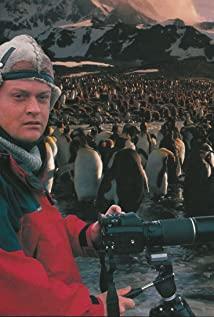l Introduction
"Hunting" is a nature documentary produced by the BBC. It was created by the Frozen Planet team. It took 3 years and traveled to more than 30 countries to shoot the material.
The perspective of this series mainly focuses on the relationship between predators and prey, the strategies of predators, etc. The film crew captured many suffocating rare scenes, for example, killer whales jointly attacked huge humpback whales, which can spit out 25 meters Darwin's bark spider with long silk.
The film crew covered rain forests, permafrost, oceans, grasslands, polar regions, and typical ecological environments. They also recorded the efforts of various scientists and environmentalists to protect endangered animals.
l Notes
Ep. 1 The Hardest Challenge
The duel between hunter and prey in nature is splendid and full of drama, it is a very costly bet, it is life and death for both sides, but surprisingly, the hunter is often the loser. In order to seize every chance of survival, hunters must be highly acclimated to the hunting grounds.
Leopard leopard? Impala impala/Puku red antelope
African Wild dog African wild dog? Oribi wildebeest/Wildebeest wildebeest
Parson's chameleon king chameleon? Stick insect
Nasutum chameleon nose-horned chameleon? Mantis mantis
Darwin's bark spider? Dragonfly
Nile crocodile Nile crocodile? Wildebeest
Amur falcon Amur falcon? Winged termite long-winged termite / Alate long-winged flying insect
Orca killer whale? Humpback whale
Cheetah cheetah? Gazelle gazelle
Ep. 2 In the Grip of the Seasons (Arctic)
The Arctic hinterland in winter is one of the worst living conditions on earth. Only three top predators, polar bears, arctic foxes and arctic wolves, can hunt here. Polar bears eat two-thirds of their annual food reserves before the sun melts the ice. All these arctic hunters have to hunt hard when food is most abundant to survive periods of scarcity.
Polar bear? Beard Seal mane seal/Walrus walrus/Guillemot guillemot
Arctic wolf? Arctic hare/Musk oxen
Arctic fox? Arctic skua
Glaucous gull arctic gull? Little auk
Ep. 3 Hide and Seek (Forests)
Forests are where half of the planet's animal species hide, a complex hunting environment. Tigers are the largest animals among forest hunters. Invisibility takes years to master, and this training is their child's skill. Like domestic cats, stalking prey is an innate urge in tiger cubs, and tigers can easily catch prey in the forest. Hunting in the forest requires perseverance, and tiger cubs experience many failures to catch their prey.
Tiger Tiger? Monkey Monkey/Deer Deer
American marten? Mouse
Sparrowhawk? Jay Jay
Portia spider? Spitting Spider
Reticulated python reticulated python ? Tarsier tarsier
Harpy Eagle? Monkey monkey/Three-toed sloth three-toed sloth
Chimpanzee? Colobus Monkey
Army ant? Black ant
Ep. 4 Hunger at Sea (Oceans)
There are all kinds of predators living in the vast ocean. Some spend their whole lives wandering around in search of those elusive prey; some stay in place, using camouflage and mimicry to launch unexpected attacks when the prey is not prepared. The most striking of these is the blue whale, the largest marine creature we know of in the world. Let's take a look at the splendid appearance of these predators at the moment of hunting.
Blue whale? Krill Krill
Frigate bird/Dorado mahi? Flying fish
Sargassum fish
Spinner dolphin? Lantern fish
Boroe melon jellyfish? Ctenophore
Chiroteuthis Marshal Hand Squid? Shrimp Shrimp
Lionfish lionfish?fish
Silky shark/Hammerhead shark/Striped bonito/Golden trevalley toothless trevally? Silverside Silverside
Black-browed albatross? Krill Krill
Pelagic red crabs Pelagic red crabs? Plankton plankton
Sea lion/Tuna tuna/Shearwater shearwater/Copper shrak/Common dolphin/Bryde's whale? Sardine
Blue whale? Krill Krill
Ep. 5 Nowhere to Hide (Plains)
With nearly half of the planet covered in deserts and grasslands, the most unobstructed habitat on our planet, the tension between predator and prey is more pronounced than anywhere else. Here, ambushes and surprise attacks are almost impossible. Their incredible agility and speed can only be truly appreciated from the air.
Cheetah Cheetah? Impala Impala/Wildebeest Wildebeest
Caracal caracal? Guinea fowl guinea fowl
Honey badger? Rodents Rodents/Scorpion Scorpion/Ostrich egg Ostrich egg
Headlight beetle larva larvae? Termite termite
Bald eagle? America's snow goose
Lion Lion? Cape buffalo African Buffalo/Zebra Zebra
Ethiopian wolf? Giant mole rat/Grass rat
Antlion larva larvae? Hotrod ant long-legged desert ant
Spoor spider? Hotrod ant
Ep. 6 Race Against Time (Coasts)
The land at the junction of land and sea is the most rapidly changing. No predators will stay in this right and wrong place all year round. The waiting predators need the right time and the right place to hunt successfully. Whether it is a group attack or a solo action, hunters must obey the law of coastal predation in order to fill their stomachs. Because of this, these predators have to do everything they can to win the hunt in a race against time.
Bottlenose dolphin/Heron heron/Gull seagull? Oyster oyster
Octopus ? Crab
Soldier crab Hermit Crab/Sand bubbler crab Ball Stock Window Crab? Plankton Plankton
Long-tailed macaque? Sea snail/Rock oyster/Crab
South American marine otter? Crab
Brown bear/Wolf/Seal? Salmon
Peregrine falcon? Wader wader
Orca killer whale? Patagonian sea lion
Humpback whale/Codfish? Capeline capelin
Ep. 7 Living with Predators (Conservation)
Predators are indicators of the health of the planet's wild environment. They are at the top of the food chain and require ample prey and open hunting grounds. But human-animal conflicts are also escalating as human populations increase. More than 75 percent of the world's top predator populations are declining, and humans are causing the crisis.
Human? India's Tiger/Harpy eagle/Lion/Cheetah/African Wild dog/Blue whale/Ice bear
l Short Comments
In a complex world, hunting is a never-ending game of hide-and-seek.
The earth was originally calm, barbaric, cruel, and tolerant. This is the real face of the world. Society is just a castle in the air built on the ground of nature. We who were born in a civilized society are full of security. The rainforests, permafrost, oceans, grasslands, and polar regions in the lens tell us that nature has never felt safe. In nature, hunting and avoiding are one of the languages of communication among living beings. Death is the most naked manifestation of the law of the jungle. The change of life and death is as common as breathing. The world is insecure. Humans' need for a sense of security derives from the need to rule and be ruled, to be regulated and to be regulated, law and morality emerge as the times require, and at the same time, various rules and standards are derived. That is to say, right or wrong, good or bad, honor or disgrace, strength or weakness, promotion or rejection, praise or criticism...all the measurement standards are artefacts.
Except for nature itself, everything is questionable.
There is no prejudice against the prey, no sympathy for the prey, only cool observation as a bystander. You don't hate the crocodile when you see it go all out to hunt a wildebeest, because you've seen it starve itself for almost a whole year to wait for this moment; and you don't scold the polar bear Even such a small seal pup refuses to let go, because you have seen that after the freezing season, it will also be as thin as a lost dog because it will not have any food for a few months; you will even sympathize with the most Disgusting hyenas, because you see them in order to raise their own children, they dare to provocatively hunt wildebeest several times larger than their own body, through the strength of the team, use the wisdom of cooperation, defeat the huge prey, get rich Food; although sometimes it will make you feel a little uncomfortable when you see the gorilla, a close relative of human beings, killing another close relative of human beings, the colobus monkey, but it will also make you more soberly aware of the cruelty and reality of nature.
Every species will do its best to survive, even if it pays the price of broken bones. Although the biological chain has been formed, the winner is the king, and the loser will only become the king's meal in the end, but there is no reason to give up or compromise easily.
Whether it's a cheetah, a tiger, a lion, or a polar bear, brown bear, or bald eagle, even if they are at the top of the biological chain, they still fail 80 times out of 100 in hunting, and it is in these failures , they become more patient, know their opponents better, and know how to hide themselves.
View more about The Hunt reviews


